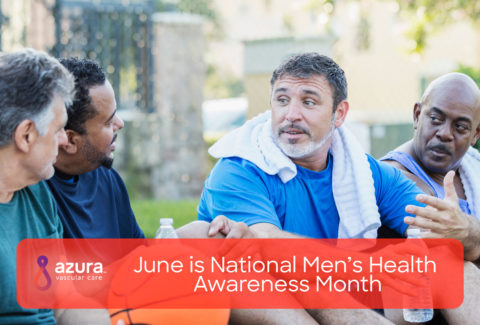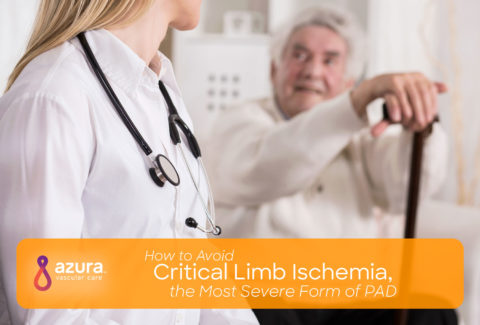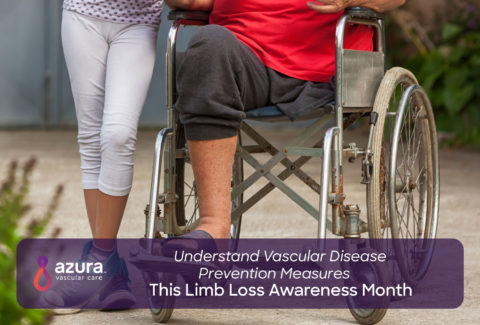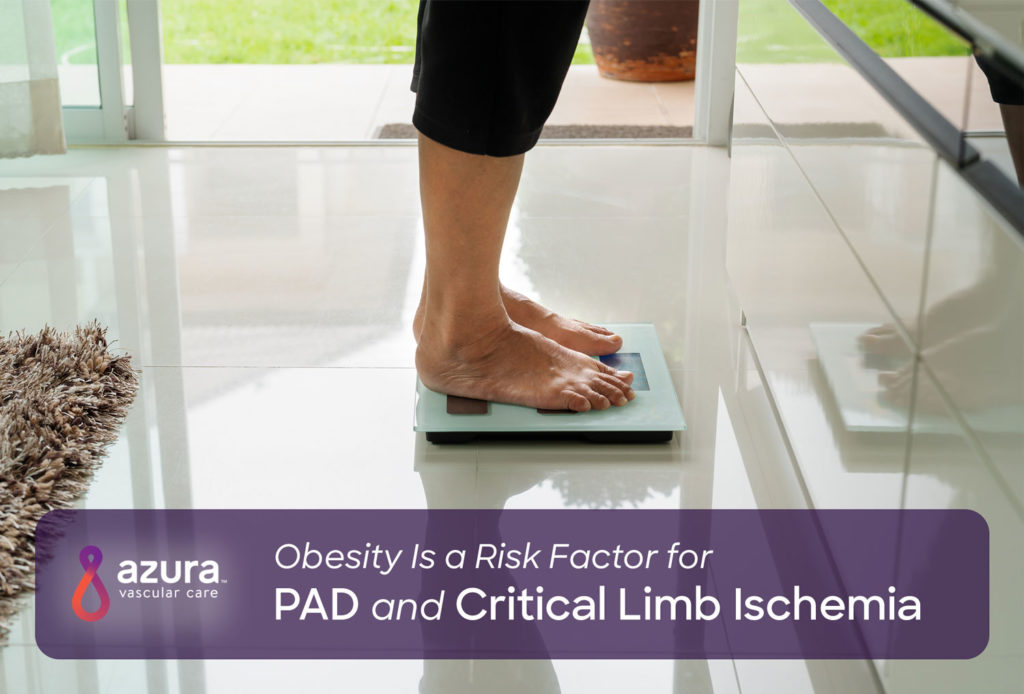
If you or a loved one has recently been diagnosed with peripheral artery disease (PAD), you probably have many questions. What causes this disease? What complications might develop? Is there anything you can do to preserve vascular health?
PAD is a progressive disease and will get worse without treatment. However, early diagnosis and treatment can help prevent PAD from advancing to critical limb ischemia (CLI), a serious form of PAD that may necessitate amputation of the affected limb. Read on to learn more about the weight-related risk factor for PAD and critical limb ischemia.
About PAD
PAD is a vascular disorder that affects more than 8 million people in the United States. (i) PAD is caused by atherosclerosis, a build-up of plaque in the arteries that supply blood to the legs. Atherosclerosis blocks blood flow to the legs and can deprive leg tissues of oxygen and nutrients. (ii)
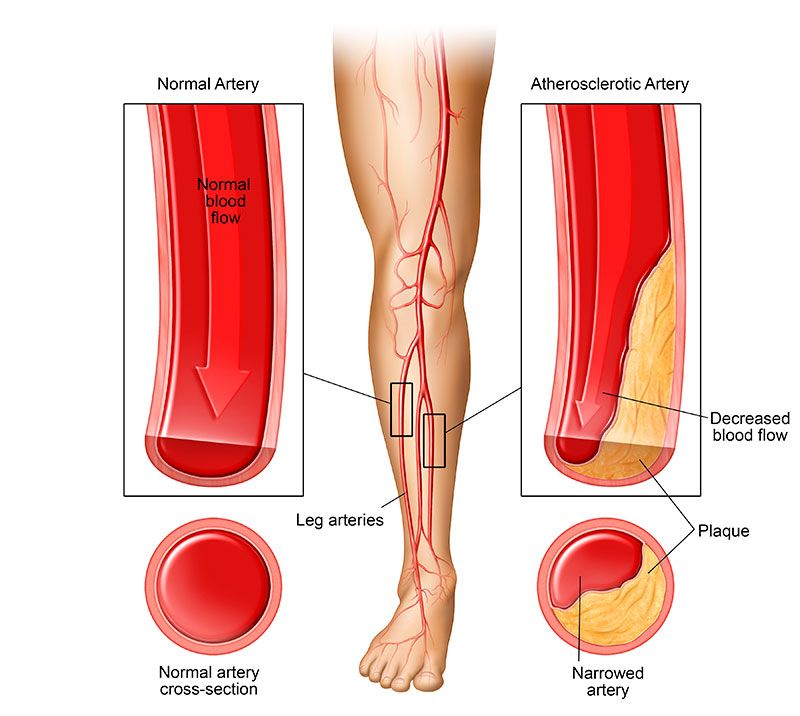
Known risk factors for PAD include high blood pressure, high cholesterol, diabetes, smoking and obesity. (iii)
An essential part of PAD treatment involves management of these risk factors. If your risk factors for PAD are not well-managed, the disease may progress more quickly and you may go on to develop CLI.
You may not be able to completely cure PAD, but managing risk factors for PAD can help prevent the disease from worsening. If you have high blood pressure, high cholesterol, or diabetes, you’ll need treatment to bring those conditions under control. (iv) If you smoke or use tobacco, it’s best to quit as soon as possible. If you’re overweight, losing weight can slow the progression of atherosclerosis. (v)
Studies on Obesity and PAD
A study published in the Journal of the American Heart Association revealed that a higher body mass index (BMI), a measure of body fat based on height and weight, increases your risk of developing PAD. Some research has indicated that obesity may cause an inflammatory response in the body. The resulting inflammation may clog your arteries and slow down healing. (vi)
For many years, doctors have known that obesity increases a person’s risk of several medical conditions, including high blood pressure and high cholesterol. Studies have suggested that obese people without high blood pressure or high cholesterol are still more likely to develop PAD.
Recent medical research shows that obesity increased many risks associated with PAD, even when other risk factors like smoking were excluded. (vi) The study determined that obesity significantly increases your chances of being hospitalized for complications related to PAD or CLI, and that obese patients with PAD were also more likely to experience CLI.
Some patients may think there’s no point in losing weight if they already have PAD, but maintaining a healthy weight can greatly decrease the chances of developing CLI.
Should I Be Concerned About Critical Limb Ischemia?
People with CLI usually experience severe leg or foot pain that doesn’t get better with rest. (vii) CLI is the most advanced stage of PAD. Once CLI develops, it can be very difficult for doctors to repair the damage. Even with treatment, up to 40 percent of patients with CLI may require limb amputation within a year. (vi)
Not everyone with PAD goes on to develop CLI. However, if your PAD isn’t properly treated, you may still experience a variety of complications. Severe PAD may require hospitalization or painful surgeries, including amputation.
What Can People with PAD Do to Reduce Their Risk of Complications?
If you have PAD and you’re overweight or obese, losing weight can help decrease your chances of developing complications like CLI.
Your doctor can help you develop a treatment plan for shedding excess pounds safely and effectively. Other lifestyle changes can also help promote a healthy circulatory system. Your doctor may suggest that you: (v)
- Get more exercise.
- Eat a heart-healthy diet.
- Quit smoking.
- Reduce stress levels.
Medications can also help manage several risk factors, including high blood pressure and diabetes. (iv) If you have these conditions, be sure to follow up with your doctor’s recommended treatments. Uncontrolled diabetes or high blood pressure can significantly increase your risk of developing CLI.
For some patients, lifestyle changes and medications aren’t enough to halt the progression of PAD. If your PAD symptoms are getting worse, your doctor may recommend minimally invasive or surgical procedures to help open up blocked arteries. (iv)
Some procedures used to treat PAD include:
- Angioplasty
- Stent placement
- Atherectomy
- Graft bypass surgery
- Thrombolytic therapy
Many patients may wait until their symptoms worsen before seeking treatment. However, it’s important to understand the risks that come with delaying treatment. When tissues in your body don’t receive enough oxygen and nutrients, they can be permanently destroyed. Lack of oxygen can lead to infected sores or tissue death.
It’s essential that PAD patients receive the care they need before they develop complications like CLI. If you’re concerned about PAD, remember that many risk factors for critical limb ischemia can be successfully managed. The right treatment can keep your vascular system healthy and prevent life-threatening complications. Take our free PAD risk assessment and discover if you are at risk for PAD. Then call 866-LEG-DOCS (534-3627) to schedule an appointment with a vascular specialist.
Sources:
(i) National Heart, Lung, and Blood Institute. Facts about peripheral arterial disease (PAD). Retrieved October 24, 2018, from https://www.nhlbi.nih.gov/health/educational/pad/materials/pad_extfctsht_general.html
(ii) MedlinePlus. (2018, August 8). Peripheral arterial disease. Retrieved October 22, 2018, from https://medlineplus.gov/peripheralarterialdisease.html
(iii) Mayo Clinic. (2018, July 17). Peripheral artery disease: Symptoms & causes. Retrieved October 22, 2018, from https://www.mayoclinic.org/diseases-conditions/peripheral-artery-disease/symptoms-causes/syc-20350557
(iv) Mayo Clinic. (2018, July 17). Peripheral artery disease: Diagnosis & treatment. Retrieved October 22, 2018, from https://www.mayoclinic.org/diseases-conditions/peripheral-artery-disease/diagnosis-treatment/drc-20350563
(v) MedlinePlus. (2018, August 8). Atherosclerosis. Retrieved October 22, 2018, from https://medlineplus.gov/atherosclerosis.html
(vi) Hicks, C.W., Yang, C., Ndumele, C.E., Folsom, A.R., Heiss, G., Black, J.H., . . . Matsushita, K. (2018). Associations of obesity with incident hospitalization related to peripheral artery disease and critical limb ischemia in the ARIC study. Journal of the American Heart Association,7(16), DOI: 10.1161/JAHA.118.008644
(vii) UC Davis Health. Critical limb ischemia (CLI). Retrieved October 24, 2018, from https://www.ucdmc.ucdavis.edu/vascular/diseases/cli.html
